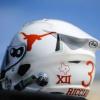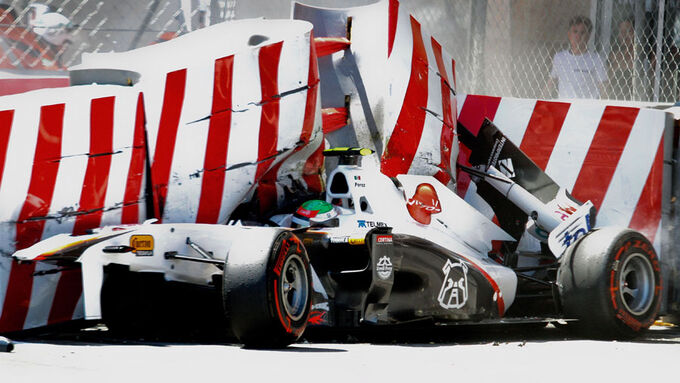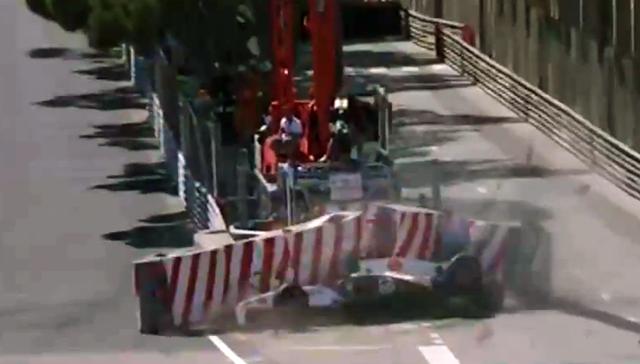The SAFER barrier is designed for a different scenario where there is limited space to install any other type of barrier and the predominant impact is at a shallow angle - the design of the barrier allowing the car to slide along the barrier scrubbing off speed.
I'm not an expert on crash barriers, but I think the SAFER barrier looks like a much better system than Tecpro. But maybe you're right that it's more suited for a shallow impact, I don't know.
Anyway, we saw what happened to Sainz: The car went underneath the barrier, not necessarily because of the low nose but because there is nothing that will prevent the rows of Tecpro blocks from moving upward. It seemed to take a while to reach him and it took about twenty minutes to get him out of the car. The barriers are heavy and have to be lifted by a crane. And yes, they landed on top of the car. That's not good.
Now
here's a video of Max Chilton hitting a Tecpro barrier in Abu Dhabi. The 2011 GP2 car had a higher nose and the car didn't go underneath. But look at the replay at 0:37 and you'll see the nose digging into the barrier, lifting it from the ground, and that caused the front of the car to lift as well. That can't be any good to the driver.
Then there was
Maldonado's accident in Monaco in 2013 where he hit the first block of Tecpros at Tabac and the entire barrier was dragged onto the track, one of the blocks hitting both Marussias.
And look at what happened to
Grosjean in Sochi: The right rear wheel dug into the barrier, causing massive damage not only to the barrier from which bits of foam were flying everywhere (replacing the blocks would take a long time, so the holes were patched with duct tape!); the back of the car was heavily damaged too, fluids leaking from it; and I suspect that at the initial impact, the car was rotated more violently than it would have been had it hit an armco barrier, a concrete wall, or a SAFER barrier.
Now, I didn't pay much attention to that last bit until I read this
transcript from a 2002 SAFER barrier press conference in which the researchers explain why they found it a good idea to let drivers hit a skin of steel rather than polyethylene. Here are some highlights:
First generation of this system is called the PEDS Barrier … And the first impact was by Arie Luyendyk. … Although the energy absorbing system functioned and dissipated the energy of the impact, it did cause the vehicle to careen across the track at a high angle and distributed much of the barrier out into the track … Although the barrier did help save Arie's life, it created some other problems. … The PEDS-2 Barrier functions on the same basic principal as the PEDS 1 Barrier, but significantly strengthened to try to increase its energy dissipation characteristic and control the debris field that was generated by the first impact, as you can see by the impact by Hideshi Matsuda during Indianapolis 500. … We then moved back onto our test track to begin to test this system and others … One of the things we looked at was high-density polyethylene skin system, as you see here. It uses high-density polyethylene sheets as the energy dissipation mechanism, and then a high-density skin on the surface. Notice the significant pocketing around these sheet energy absorbers. The pocketing causing significant longitudinal and lateral decelerations. It literally slows the front of the car down, pulls it into the barrier, thereby increasing the risk to injury of the driver. Notice how this vehicle instead of being straightened, the front of the vehicle is actually stopped it causes the vehicle to spin out, increasing the risk of injury to the occupants. This was a behavior our analysis showed that occurred any time we had a high-density polyethylene skin associated with discrete energy absorber, either polyethylene tube or polyethylene sheet. Any of those discrete energy absorbers would allow this significant pocket. Based on that result, included that if we wanted to use the high-density polyethylene skin, we had to move to a distributed foam energy absorbing system that would eliminate that high degree of pocketing. … It did help limit some of the lateral acceleration and the vehicle trajectory was very good. But we were very concerned about pocketing we observed in both of the first two tests. We then went to a steel skin system. The principal here is to provide a tubular steel wall with tremendous bending strength. The bending strength of the wall element will prevent it from wrapping around the front of the car and virtually eliminate the pocketing. As you see here, there's no pocketing of this vehicle inside this barrier. We also coated the surface of this barrier with zinc rich paint. The zinc provides a lubricant, which further reduces the friction between the vehicle from the barrier. By reducing the friction, we reduced the longitudinal deceleration, which, again, as I mentioned previously, longitudinal deceleration pulls the car into the barrier, increasing the acceleration of the driver.
So while I'm sure that Tecpro barriers have saved some drivers from injuries that they would have sustained had they hit a tyre wall, it doesn't really seem like it's a perfect design.




















